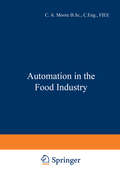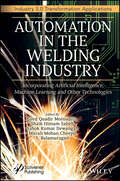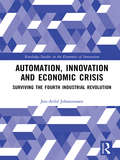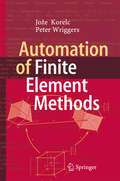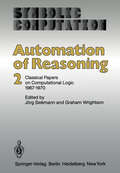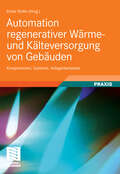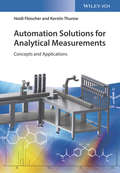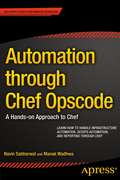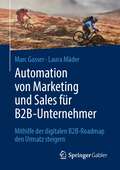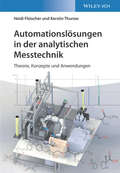- Table View
- List View
Automation in the Food Industry
by C. A. MooreThis book is designed to be everything its title suggests-a practical guide to automation within the food industry. It is the first book to offer practical advice on what can be a most bewildering subject in an industry where the use of effective automation is of paramount importance. There are many books dealing with the theory and practice of control systems in both the food and other industries. However, these tend to offer too much detail in both areas to be classed as overviews, or cover too much of the more obvious detail and gloss over, or avoid, the elements where the decisions are hard-even though these are the areas which are fundamental to successful and expansive projects. This book identifies those elements of any automation scheme which have to be considered first, and that form the foundations for any successful project. The editorial introduction outlines the content of the book and is a useful starting point. Examples are used, wherever possible, to show what can be done, how it can be achieved, and what to avoid. A glossary of definitions is included at the end of the book. All the chapters have been written by engineers, with many years' experience in this field, who have been able to express their views freely. The result is a book which covers the key areas of the subject, using a minimum of the technical jargon with which this subject abounds, in a readable, practical manner.
Automation in the Virtual Testing of Mechanical Systems: Theories and Implementation Techniques
by Ole Ivar Sivertsen Bjorn HaugenAutomation in the Virtual Testing of Mechanical Systems: Theories and Implementation Techniques provides a practical understanding of Knowledge-Based Engineering (KBE), an approach that is driving automation in engineering. Companies are using the technology to automate engineering tasks, achieving gains in output, and saving time. This book will be the main source of information available for implementing KBE systems, integrating KBE with the finite element methods, and showing how KBE is used to automate engineering and analysis of mechanical systems. The process of combining KBE with optimization techniques is explored, and the use of software tools is presented in some detail. Features Introduces automation with Knowledge-Based Engineering (KBE) in generic mechanical design Develops a framework for generic mechanism modeling including a library format Explores a KBE environment for generic design automation Includes design cases in KBE Gives a presentation of the interwoven technologies used in modern design environments
Automation in the Welding Industry: Incorporating Artificial Intelligence, Machine Learning and Other Technologies (Industry 5.0 Transformation Applications)
by Syed Quadir Moinuddin Shaik Himam Saheb Ashok Kumar Dewangan Murali Mohan Cheepu S. BalamuruganAUTOMATION IN THE WELDING INDUSTRY This volume serves as a multidimensional perspective of welding practices in Industry 5.0 from the perspective of automation, digitization, digital twins, cobots, virtual reality, augmented reality, machine learning, artificial intelligence, and IoT ranging from rudiments to advanced applications. This book introduces the concept of Industry 5.0 in welding technologies, where the human brain collaborates with robots to achieve rapid productivity and economic efficiency. It presents the latest information on adapting and integrating Industry 5.0 in welding industries through critical constituents such as artificial intelligence (AI), machine learning (ML), Internet of Things (IoT), digital twin, augmented and virtual reality (AR & VR), and collaborative robots (Cobots), towards intelligent welding systems. The chapter authors have comprehensively addressed the issues related to welding industries such as a shortage of welders, challenges in critical applications, creating defect-free and quality products through real-time monitoring, feedback systems, and in situ adjustments, etc. The utilization of cobots in welding technology is addressed in real-world problems to move towards a green welding environment (i.e., minimal fumes with less shielding gas) and thereby, less energy consumption. Two or more welding processes are combined to form a hybrid process where the compatibility of existing materials and novel materials can be used in 3D, 4D, and 5D printing of complex geometries. Audience Engineering research scholars, industry welding, and additive manufacturing groups. A diverse group of industries will be interested in this book, such as medical, automotive, construction, pipeline, shipping, aerospace, etc.
Automation in the Welding Industry: Incorporating Artificial Intelligence, Machine Learning and Other Technologies (Industry 5.0 Transformation Applications)
by Syed Quadir Moinuddin Shaik Himam Saheb Ashok Kumar Dewangan Murali Mohan Cheepu S. BalamuruganAUTOMATION IN THE WELDING INDUSTRY This volume serves as a multidimensional perspective of welding practices in Industry 5.0 from the perspective of automation, digitization, digital twins, cobots, virtual reality, augmented reality, machine learning, artificial intelligence, and IoT ranging from rudiments to advanced applications. This book introduces the concept of Industry 5.0 in welding technologies, where the human brain collaborates with robots to achieve rapid productivity and economic efficiency. It presents the latest information on adapting and integrating Industry 5.0 in welding industries through critical constituents such as artificial intelligence (AI), machine learning (ML), Internet of Things (IoT), digital twin, augmented and virtual reality (AR & VR), and collaborative robots (Cobots), towards intelligent welding systems. The chapter authors have comprehensively addressed the issues related to welding industries such as a shortage of welders, challenges in critical applications, creating defect-free and quality products through real-time monitoring, feedback systems, and in situ adjustments, etc. The utilization of cobots in welding technology is addressed in real-world problems to move towards a green welding environment (i.e., minimal fumes with less shielding gas) and thereby, less energy consumption. Two or more welding processes are combined to form a hybrid process where the compatibility of existing materials and novel materials can be used in 3D, 4D, and 5D printing of complex geometries. Audience Engineering research scholars, industry welding, and additive manufacturing groups. A diverse group of industries will be interested in this book, such as medical, automotive, construction, pipeline, shipping, aerospace, etc.
Automation in Tree Fruit Production: Principles and Practice
by Qin ZhangThe technology that allows automation in agriculture is rapidly developing and being applied to wide variety of key crops. This book focuses on automation in tree fruit crops worldwide. It covers topics such as automated tree fruit production systems, plant stress sensing and high-throughput phenotyping in precision horticulture, the economics of automation in tree fruit production, light interception sensing systems for canopy management, precision irrigation and water management, precision technologies for pest and disease management, opportunities for the application of robotics in tree fruit production, and the mechanical harvesting and handling of fruit crops.
Automation in Warehouse Development
by Roelof Hamberg and Jacques VerrietThe warehouses of the future will come in a variety of forms, but with a few common ingredients. Firstly, human operational handling of items in warehouses is increasingly being replaced by automated item handling. Extended warehouse automation counteracts the scarcity of human operators and supports the quality of picking processes. Secondly, the development of models to simulate and analyse warehouse designs and their components facilitates the challenging task of developing warehouses that take into account each customer’s individual requirements and logistic processes. Automation in Warehouse Development addresses both types of automation from the innovative perspective of applied science. In particular, it describes the outcomes of the Falcon project, a joint endeavour by a consortium of industrial and academic partners. The results include a model-based approach to automate warehouse control design, analysis models for warehouse design, concepts for robotic item handling and computer vision, and autonomous transport in warehouses.Automation in Warehouse Development is targeted at both academic researchers and industrial practitioners. It provides state-of-the art research on warehouse automation and model-based warehouse design. These topics have been addressed from a systems engineering perspective by researchers from different disciplines including software, control, and mechanical engineering, with a clear focus on the industrial applications of their research.
Automation, Innovation and Economic Crisis: Surviving the Fourth Industrial Revolution (Routledge Studies in the Economics of Innovation)
by Jon-Arild JohannessenThe fourth industrial revolution is developing globally, with no geographical centre. It is also taking place at enormous speed. This development will shape the workplaces of the future, which will be entirely different from the workplaces created by the first, second and third industrial revolutions. Industry created the industrial worker. The knowledge society will create a new type of "industrial worker", the knowledge worker. While the third industrial revolution was concerned with the digitalization of work, in the fourth industrial revolution, robots will bring about the informatization of work. Many of these robots will be systematically connected, such that they can obtain updated information and learn from their own and others’ mistakes. The way we work, where we work, what we work on, and our relationships with our colleagues and employers are all in a state of change. The workplace of the future will not necessarily be a fixed geographical location, but may be geographically distributed and functionally divided. In his book, Jon-Arild Johannessen argues that a "perfect" social storm occurs when inequality grows at a catastrophic rate, unemployment increases, job security is threatened for a growing number and robotization takes over even the most underpaid jobs. Thus, the ingredients for a perfect social storm will be brought forward by cascades of innovations that will most likely lead to economic and social crises and he argues that it is reasonable to assume that it will only take a small spark for this social storm to develop into a social revolution.
Automation, Innovation and Economic Crisis: Surviving the Fourth Industrial Revolution (Routledge Studies in the Economics of Innovation)
by Jon-Arild JohannessenThe fourth industrial revolution is developing globally, with no geographical centre. It is also taking place at enormous speed. This development will shape the workplaces of the future, which will be entirely different from the workplaces created by the first, second and third industrial revolutions. Industry created the industrial worker. The knowledge society will create a new type of "industrial worker", the knowledge worker. While the third industrial revolution was concerned with the digitalization of work, in the fourth industrial revolution, robots will bring about the informatization of work. Many of these robots will be systematically connected, such that they can obtain updated information and learn from their own and others’ mistakes. The way we work, where we work, what we work on, and our relationships with our colleagues and employers are all in a state of change. The workplace of the future will not necessarily be a fixed geographical location, but may be geographically distributed and functionally divided. In his book, Jon-Arild Johannessen argues that a "perfect" social storm occurs when inequality grows at a catastrophic rate, unemployment increases, job security is threatened for a growing number and robotization takes over even the most underpaid jobs. Thus, the ingredients for a perfect social storm will be brought forward by cascades of innovations that will most likely lead to economic and social crises and he argues that it is reasonable to assume that it will only take a small spark for this social storm to develop into a social revolution.
Automation Is a Myth
by Luke MunnFor some, automation will usher in a labor-free utopia; for others, it signals a disastrous age-to-come. Yet whether seen as dream or nightmare, automation, argues Munn, is ultimately a fable that rests on a set of triple fictions. There is the myth of full autonomy, claiming that machines will take over production and supplant humans. But far from being self-acting, technical solutions are piecemeal; their support and maintenance reveals the immense human labor behind "autonomous" processes. There is the myth of universal automation, with technologies framed as a desituated force sweeping the globe. But this fiction ignores the social, cultural, and geographical forces that shape technologies at a local level. And, there is the myth of automating everyone, the generic figure of "the human" at the heart of automation claims. But labor is socially stratified and so automation's fallout will be highly uneven, falling heavier on some (immigrants, people of color, women) than others. Munn moves from machine minders in China to warehouse pickers in the United States to explore the ways that new technologies do (and don't) reconfigure labor. Combining this rich array of human stories with insights from media and cultural studies, Munn points to a more nuanced, localized, and racialized understanding of the "future of work."
Automation of Finite Element Methods
by Jože Korelc Peter WriggersNew finite elements are needed as well in research as in industry environments for thedevelopment of virtual prediction techniques. The design and implementation of novel finiteelements for specific purposes is a tedious and time consuming task, especially for nonlinearformulations. The automation of this process can help to speed up this processconsiderably since the generation of the final computer code can be accelerated by order ofseveral magnitudes.This book provides the reader with the required knowledge needed to employ modernautomatic tools like AceGen within solid mechanics in a successful way. It covers the rangefrom the theoretical background, algorithmic treatments to many different applications. Thebook is written for advanced students in the engineering field and for researchers ineducational and industrial environments.
Automation of Reasoning: 2: Classical Papers on Computational Logic 1967–1970 (Symbolic Computation)
by J. Siekmann G. Wrightson"Kind of crude, but it works, boy, it works!" AZan NeweZZ to Herb Simon, Christmas 1955 In 1954 a computer program produced what appears to be the first computer generated mathematical proof: Written by M. Davis at the Institute of Advanced Studies, USA, it proved a number theoretic theorem in Presburger Arithmetic. Christmas 1955 heralded a computer program which generated the first proofs of some propositions of Principia Mathematica, developed by A. Newell, J. Shaw, and H. Simon at RAND Corporation, USA. In Sweden, H. Prawitz, D. Prawitz, and N. Voghera produced the first general program for the full first order predicate calculus to prove mathematical theorems; their computer proofs were obtained around 1957 and 1958, about the same time that H. Gelernter finished a computer program to prove simple high school geometry theorems. Since the field of computational logic (or automated theorem proving) is emerging from the ivory tower of academic research into real world applications, asserting also a definite place in many university curricula, we feel the time has corne to examine and evaluate its history. The article by Martin Davis in the first of this series of volumes traces the most influential ideas back to the 'prehistory' of early logical thought showing how these ideas influenced the underlying concepts of most early automatic theorem proving programs.
Automation of Trading Machine for Traders: How to Develop Trading Models
by Jacinta ChanThis Palgrave Pivot innovatively combines new methods and approaches to building dynamic trading systems to forecast future price direction in today’s increasingly difficult and volatile financial markets. The primary purpose of this book is to provide a structured course for building robust algorithmic trading models that forecast future price direction. Chan provides insider information and insights on trading strategies; her knowledge and experience has been gained over two decades as a trader in foreign exchange, stock and derivatives markets. She guides the reader to build, evaluate, and test the predictive ability and the profitability of abnormal returns of new hybrid forecasting models.
Automation, Production Systems, and Computer-Integrated Manufacturing, Global Edition
by Mikell GrooverAutomation, Production Systems, and Computer-Integrated Manufacturing is appropriate for advanced undergraduate/ graduate-level courses in Automation, Production Systems, and Computer-Integrated Manufacturing. This exploration of the technical and engineering aspects of automated production systems provides the most advanced, comprehensive, and balanced coverage of the subject of any text on the market. It covers all the major cutting-edge technologies of production automation and material handling, and how these technologies are used to construct modern manufacturing systems. Teaching and Learning ExperienceThis book will provide a better teaching and learning experience—for you and your students. It will help: Provide Balanced Coverage of Automated Production Systems: A quantitative approach provides numerous equations and example problems for instructors who want to include analytical and quantitative material in their courses. Support Learning: End-of-chapter problems, review questions, and problem exercises give students plenty of opportunities to put theory into action. Keep Your Course Current: This edition provides up-to-date coverage of production systems, how they are sometimes automated and computerized, and how they can be mathematically analyzed to obtain performance metrics.
Automation regenerativer Wärme- und Kälteversorgung von Gebäuden: Komponenten, Systeme, Anlagenbeispiele
by Elmar Bollin Martin Becker Ekkehard Boggasch Mathias Fraaß Alfred Karbach Peter Ritzenhoff Dieter StriebelDieses Fachbuch gibt eine kompakte Übersicht über regenerative Systeme zur Wärme- und Kälteerzeugung. Einbindungs- und Automatisierungsschemata ermöglichen einen schnellen Überblick. Es werden die Grundlagen zum Regelverhalten von Systemen zur regenerativen Energienutzung dargestellt. Praxisbeispiele zeigen anschaulich Standardlösungen zur Einbindung von regenerativen Energiequellen.
Automation Solutions for Analytical Measurements: Concepts and Applications
by Heidi Fleischer Kerstin ThurowThe first book dedicated specifically to automated sample preparation and analytical measurements, this timely and systematic overview not only covers biological applications, but also environmental measuring technology, drug discovery, and quality assurance. Following a critical review of realized automation solutions in biological sciences, the book goes on to discuss special requirements for comparable systems for analytical applications, taking different concepts into consideration and with examples chosen to illustrate the scope and limitations of each technique.
Automation Solutions for Analytical Measurements: Concepts and Applications
by Heidi Fleischer Kerstin ThurowThe first book dedicated specifically to automated sample preparation and analytical measurements, this timely and systematic overview not only covers biological applications, but also environmental measuring technology, drug discovery, and quality assurance. Following a critical review of realized automation solutions in biological sciences, the book goes on to discuss special requirements for comparable systems for analytical applications, taking different concepts into consideration and with examples chosen to illustrate the scope and limitations of each technique.
Automation through Chef Opscode: A Hands-on Approach to Chef
by Navin Sabharwal Manak WadhwaAutomation through Chef Opscode provides an in-depth understanding of Chef, which is written in Ruby and Erlang for configuration management, cloud infrastructure management, system administration, and network management. Targeted at administrators, consultants, and architect, the book guides them through the advanced features of the tool which are necessary for infrastructure automation, devops automation, and reporting. The book presumes knowledge of Ruby and Erlang which are used as reference languages for creating recipes and cookbooks and as a refresher on them to help the reader get on speed with the flow of book. The book provides step by step instructions on installation and configuration of Chef, usage scenarios of Chef, in infrastructure automation by providing common scenarios like virtual machine provisioning, OS configuration for Windows, Linux, and Unix, provisioning and configuration of web servers like Apache along with popular databases like MySQL. It further elaborates on the creation of recipes, and cookbooks, which help in deployment of servers and applications to any physical, virtual, or cloud location, no matter the size of the infrastructure. The books covers advanced features like LWRPs and Knife and also contains several illustrative sample cookbooks on MySQL, Apache, and CouchDB deployment using a step by step approach.
Automation und Computer in der Industrie / Raumzuordnung und Raumform von Büro- und Fabrikgebäuden (Arbeitsgemeinschaft für Forschung des Landes Nordrhein-Westfalen #170)
by John Flavell CoalesAutomation und Entscheidung: Möglichkeiten und Probleme eines ganzheitlichen Informations- und Entscheidungssystems
by Karl-Georg HoltgreweProbleme der Automation beherrschen unser modernes Zeitalter. Eine stille, aber äußerst wirksame Revolution hat in den letzten Jahren stattgefunden und wird sich weiter ausbreiten. Der Computer steht im Mittelpunkt dieser Entwicklung. Das bedeutet, daß es sich hierbei nicht nur um eine konse quente Fortsetzung der Mechanisierung handelt, sondern daß geistige Funk tionen mehr und mehr in den Prozeß der Automatisierung einbezogen wer den. Wie weit kann sich dieser Prozeß auf Grund der schnellen Entwicklung der Computertechnik entfalten? Wie weit lassen sich die Funktionen eines Industrieunternehmens automatisieren, angefangen bei der einfachen Ver richtung in der Fertigung bis hin zur Unternehmerischen Entscheidung? Das vorliegende Buch sucht eine Antwort auf diese drängenden Fragen zu geben. Die Abgrenzung in deterministische und nichtdeterministische (pro babilistische) Entscheidungen erlaubt es, den Umfang der Automatisierbar keit, die mit Hilfe elektronischer Rechenanlagen zu erzielen ist, abzustecken. Das komplexe System eines Unternehmens setzt sich aus vielen einzelnen Systemen zusammen, die deterministischen oder probabilistischen Entschei dungen unterworfen sind und die, wie an Hand des Regelkreisprinzips ge zeigt wird, in mehrere hierarchisch gegliederte Regelkreise aufgeteilt wer den können. Diese Regelkreise sind je nach ihrer Entscheidungsstruktur und ihrem Anpassungsverhalten der Automatisierung zugänglich oder nicht. Die Schwierigkeiten im Anpassungsverhalten bei Mensch, Maschine und Materiallassen die Anwendung des Regelkreisprinzips auf die höheren Stu fen der Unternehmensfunktionen zunächst unmöglich erscheinen. Der Com puter eröffnet hier neue Perspektiven. Sein Einsatz und die mit seiner Hilfe möglich werdende Anwendung von Entscheidungsmodellen rücken die ver schiedenen Funktionen des Unternehmens in ein neues Licht.
Automation und Organisation: Die technische Entwicklung und ihre betriebswirtschaftlich-organisatorischen Konsequenzen (Betriebswirtschaftliche Beiträge zur Organisation und Automation #1)
by Erwin GrochlaWenn es Aufgabe dieser Schriftenreihe sein soll, betriebswirtschaftliche Bei träge zur Organisation und Automation zu publizieren, so scheint es sinnvoll, an den Anfang eine Arbeit zu setzen, die die betriebswirtschaftlichen und organisatorischen Konsequenzen der realtechnischen Entwicklung, insbeson dere in ihrer gegenwärtigen Form, der Automation, in den Grundzügen auf zeigt. Zu diesem Zweck ist es notwendig, zunächst die begrifflichen Grund lagen sowie die technische Entwicklung zur Automation darzustellen. Sodann können die betriebswirtschaftlichen Auswirkungen und der Einfluß auf die Betriebsorganisation untersucht werden. Schließlich wird ein Blick auf die Konsequenzen für die Betriebswirtschaftliche Organisationslehre geworfen. Bei dem weiten Ansatz und dem einführenden Charakter dieses ersten Bandes kann die Problematik nicht bis in die Einzelheiten verfolgt werden. Aufgabe dieser Schrift kann es nur sein, die grundlegenden Probleme und Tendenzen der Auswirkungen der Automation auf die Betriebe und die Betriebswirt schaftliche Organisationslehre aufzuzeigen und Anregungen für künftige Ar beiten auf diesem Gebiet zu geben, zumal diese speziellen Fragen in der deut schen Literatur kaum behandelt werden. Nicht unerwähnt möchte ich lassen, daß die vorliegende Schrift aus mehreren Detailuntersuchungen in den letzten Jahren gewachsen ist. Einen Teil dieser Studien auf dem Gebiet der Organisation und Automation habe ich bereits in Aufsätzen publiziert. Mit dieser Schrift kann ich meinen Plan verwirklichen, die erwähnten Gedanken und Ansätze zusammenzufassen und zu erweitern.
Automation und Unternehmensverwaltung (Veröffentlichungen der Schmalenbach-Gesellschaft #27)
by Max PietschAutomation von Marketing und Sales für B2B-Unternehmer: Mithilfe der digitalen B2B-Roadmap den Umsatz steigern
by Marc Gasser Laura MäderDie Automation von Marketing und Sales ist in Zukunft erfolgsentscheidend. Nur so können B2B-Unternehmen dem Wettbewerbsdruck weiterhin standhalten. Doch der Aufbau eines digitalen Marketing- und Salesprozesses ist aufwendig und komplex und stellt insbesondere kleinere B2B-Unternehmen vor die herausfordernde Frage: Wie kann die Digitalisierung möglichst kosteneffizient vorangetrieben werden? Anhand von Erfahrungswerten aus über 100 B2B-Digitalisierungsprojekten haben Laura Mäder und Marc Gasser das Modell der digitalen B2B-Roadmap entwickelt – eine Schritt-für-Schritt-Anleitung für die Planung, Steuerung und Skalierung von digitalem Marketing und Sales. Mithilfe der digitalen B2B-Roadmap Leads automatisiert entlang der Customer-Journey führen, einen Wettbewerbsvorteil erreichen und den Umsatz steigern. Dieses Buch ist für B2B-Unternehmer, Visionäre und Impulsgeber, die veraltete Marketing- und Salesmodelle auf den Kopf stellen und Innovation effizient vorantreiben wollen.
Automationsgerechte Lohnabzüge
by August Marx Günter MetzIn den Lohnbüros der öffentlichen und privaten Unternehmen ist die Lohnerrechnung zu einem vorrangigen, aber auch schwierigen Pro blem geworden. Gründe hierfür sind der Personalmangel in diesem Bereich, die durch den Wettbewerb bedingte Notwendigkeit zu ratio nalisieren und die Verwendung datenverarbeitender Anlagen. In der Praxis der Betriebe, gleich welcher Größe, erfordert es einen beachtlichen Zeitaufwand, die Abzüge in der Lohnerrechnung zu er mitteln. Die hierzu bestehenden gesetzlichen Regelungen, Tarifver träge und betriebsinternen Vereinbarungen enthalten eine außer ordentliche Vielfalt von Vorschriften. Ihre Kompliziertheit, besonders die der Sonderregelungen im Steuerrecht und in der Sozialversiche rung, erschwert erheblich die maschinelle Abrechnung und bedingt vielfach einen unwirtschaftlichen Einsatz der Lochkartenmaschinen und der elektronischen Rechenanlagen. Aufgrund dieser betrieblichen Erfahrungen befassen sich Praktiker privater und öffentlicher Verwaltungen sowie Vertreter der Wissen schaft, der Arbeitnehmer und der Arbeitgeber in einer AWV-Arbeits gruppe mit den Fragen der automationsgerechten Lohnerrechnung, um eine Vereinheitlichung und Vereinfachung der Abzüge zu er reichen. Herr Professor Dr. August Marx, Wirtschaftshochschule Mannheim, erhielt auf Anregung eines Wirtschaftsverbandes den wissenschaft lichen Forschungsauftrag, die derzeitigen Schwierigkeiten zu unter suchen. Sein Bericht faßt die Untersuchungsergebnisse zusammen und zeigt, daß erhebliche Rationalisierungsmöglichkeiten auf diesem Ge biet noch ungenutzt sind. Die Reformvorschläge sollten daher die Gesetzgeber und die öffentlich-rechtlichen Institutionen veranlassen, die Belange der maschinellen Abrechnung im Rahmen einer koordi- 6 Vorwort nierten Gesetzgebung zu prüfen und zu berücksichtigen. Gleiches gilt für den Abschluß der Tarifverträge durch die Tarifpartner. Es ist zu erwarten, daß sich dadurch beträchtliche Erleichterungen in den pri vaten und öffentlichen Unternehmen ergeben.
Automationslösungen in der analytischen Messtechnik: Theorie, Konzepte und Anwendungen
by Heidi Fleischer Kerstin ThurowDas Buch behandelt die Entwicklung und Systematisierung geeigneter Automatisierungssysteme in der analytischen Messtechnik. Anwendungen aus verschiedenen Bereichen werden vorgestellt, beispielsweise aus der Umweltmesstechnik, Arzneimittelentwicklung und Qualitätssicherung.
